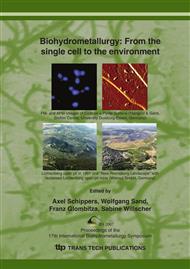[1]
Y. Kawamura, H. Yoshida, S. Asai and H. Tanibe: J. Chem. Eng. Japan Vol. 31 (1) (1998), p.1.
Google Scholar
[2]
D. Karunasagar, M. V. Balarama and S. V. Rao: J. Hazard. Mater. Vol. B118 (2005), p.133.
Google Scholar
[3]
M. Tsezos: Hydrometallurgy Vol. 59 (2001), p.241.
Google Scholar
[4]
A. Hammaini, F. Gonzalez, A. Ballester, M. L. Blázquez. and J. A Muñoz: Submitted to J. Env. Management (2006).
Google Scholar
[5]
B. Volesky: Sorption and Biosorptio, (Bx-sorbex Inc. St. Lambert, Quebec 2003).
Google Scholar
[6]
E. Guibal: Sep. Purif. Tech. Vol. 38 (2004), p.43.
Google Scholar
[7]
R. Juang, F. Wu, and R. Tseng: Wat. Res. Vol. 33 (10) (1999), p.2403.
Google Scholar
[8]
R. Kumar: React. Funct. Polym. Vol. 46 (2000), p.1.
Google Scholar
[9]
F. Peirano: MSc. Project. Marseille University (2003).
Google Scholar
[10]
I. Safarik: Wat. Res. Vol. 29 (1) (1995), p.101.
Google Scholar
[11]
A. Saglam, Y. Yalcinkaya, A. Denizli, M.Y. Arica, O. Genc and S. Bektas: Microchem. J. Vol. 71 (2002), p.73.
Google Scholar
[12]
Y. Kaçar, C. Arpa, S. Tan and A. Denizli: Process Biochem. Vol. 37 (2002), p.601.
Google Scholar
[13]
M. Chiou and H. Li: J. Hazard. Mater. Vol. B93 (2002), p.233.
Google Scholar
[14]
H. Tran and F. Roddick: Wat. Res. Vol. 33 (13) (1999), p.3001.
Google Scholar
[15]
S. Ghorai and K. Pant: Sep. Purif. Technol. Vol. 42 (2005), p.265.
Google Scholar
[16]
Z. Aksu and F. Gonen: Process Biochem. Vol. 39 (2004), p.599.
Google Scholar
[17]
Y. Sag and Y. Aktay: Process Biochem. Vol. 36 (2001), p.1187.
Google Scholar
[18]
J. Shen and Z. Duvnjak: Process Biochem. Vol. 40 (2005), p.3446.
Google Scholar
[19]
O. Hamdaoui: J. Hazard. Mater. Vol. B138 (2006), p.293.
Google Scholar
[20]
M. Tsezos: Hydrometallurgy Vol. 59 (2001), p.395.
Google Scholar
[21]
R. Han, W. Zou, H. Li, Y. Li and J. Shi: J. Hazard. Materials Vol. B137 (2006), p.934.
Google Scholar
[22]
E. Guibal, C. Milot and Jean Roussy: Wat. Env. Res. Vol. 71 (1) (1999), pp.10-0. 2 0. 4 0. 6 0. 8 1 0 100 200 300 Time (h) C / Co 0. 64 ml/min 1. 28 ml/min 1. 9 ml/min 0 0. 2 0. 4 0. 6 0. 8 1 0 50 100 150 200 250 Time (h) C / Co G2 G3 G4 a) b).
Google Scholar


